Portugal has around 800 km (500 miles) of coastline, with around 70% of it facing west, the Atlantic Ocean and the remainder, the Algarve, facing the warmer south. Portugal is a narrow country with all the population living a maximum of two hours from the coast. Given the mild temperature, it is no surprise that Portugal’s beaches are popular. And as mass tourism grew, overseas visitors soon discovered the many wonderful Portugal beaches.
The north centred around Porto is slightly cooler than the rest of the country, but it attracts significant tourism with the beaches just one of the attractions. There are also fantastic beaches in the Greater Lisbon region and heading south. The coastline turns east and faces south in the southwest corner of Portugal.
The Algarve attracts the most visitors who wish to enjoy the beaches, the warm sea and activities related to both. The Algarve has several blue-flagged beaches and resorts, large and small, providing the infrastructure for holidaymakers. We’ve chosen the best beaches in Portugal but keep in mind that it’s only a small selection and there are many more.
Contents
Best Beaches In Portugal – Atlantic North
1- Praia de Moledo
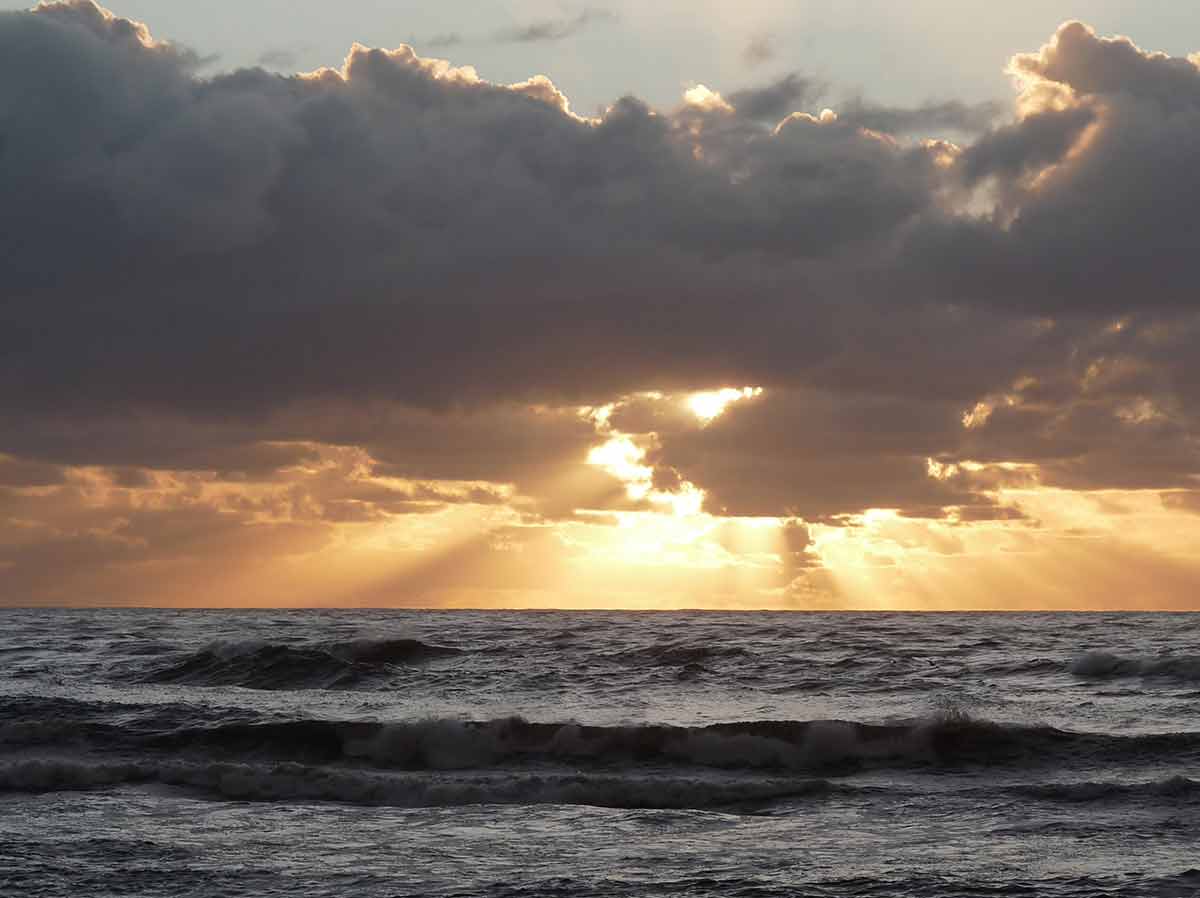 There are some amazing beaches on Portugal’s Atlantic Coast.
There are some amazing beaches on Portugal’s Atlantic Coast.Moledo became a tourist resort over a century ago for locals, attracting national celebrities and their families.
The appeal is the lovely stretch of sand, and the temperature is not as hot as it is further south.
It lies close to the Spanish border, nearly 100 km (60 miles) north of Porto.
The winds make it an excellent place for surfing and windsurfing, well beyond the high season.
It is a beautiful setting with the immediate area protected.
If you want time away from the beach, visit Insua’s small, rocky island just offshore.
Insua has a fortress, built as a convent in the 15th century that became a fortress two centuries later.
2- Praia de Sao Jacinto, Aveiro
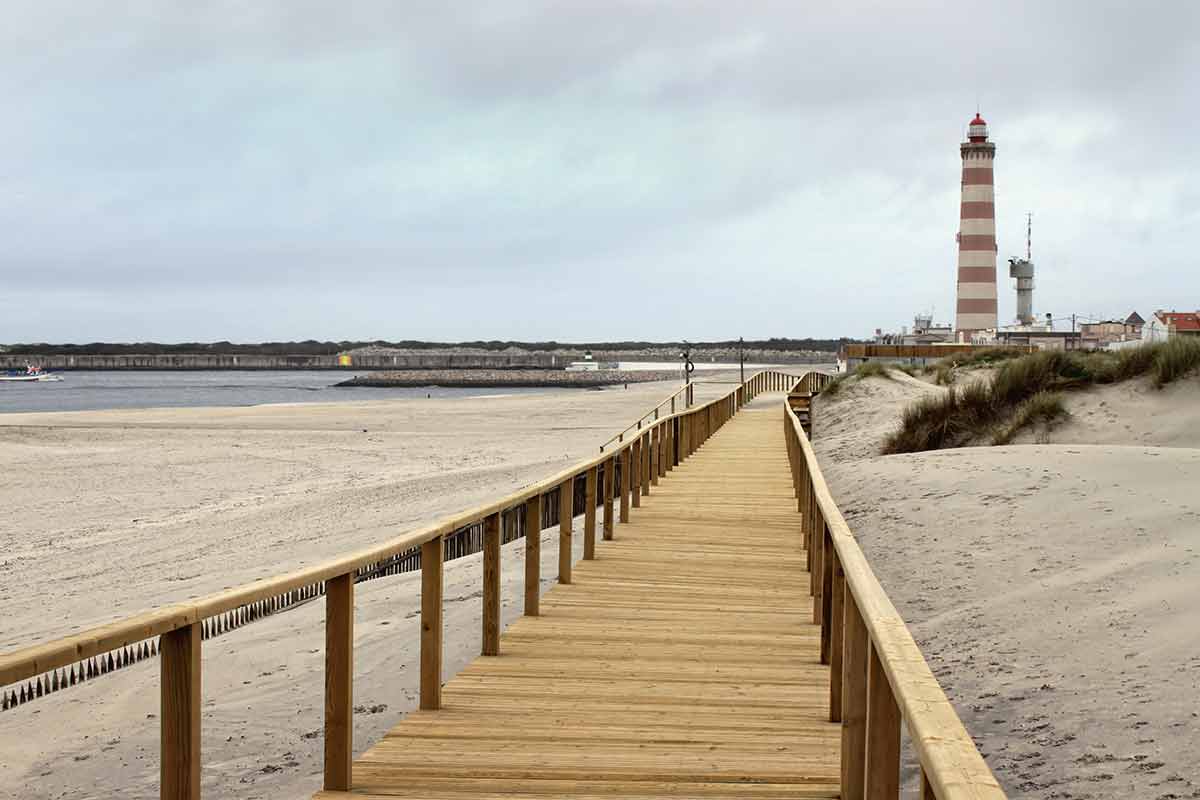 Praia Barra is an interesting Portuguese beach with a famous lighthouse, but head to Praia Sao Jacinto to escape the crowds.
Praia Barra is an interesting Portuguese beach with a famous lighthouse, but head to Praia Sao Jacinto to escape the crowds. This lovely beach lies next to Canal de Barra between Ria de Aveiro and the sea, an hour south of Porto.
A boat crosses the river backwards and forwards from the town to the beach.
If you wish to reach it by car, you have a longer route across one of the bridges.
There is a nature reserve with interesting flora and fauna.
You won’t need a car, but if you choose to drive, there is parking and a restaurant.
There is a wild feel to the beach, which is rarely crowded enough to cause you any problems.
You can stroll without seemingly getting to the end of the sands.
In common with many beaches facing the Atlantic, conditions are good for surfing.
3- Berlengas Archipelago, Peniche
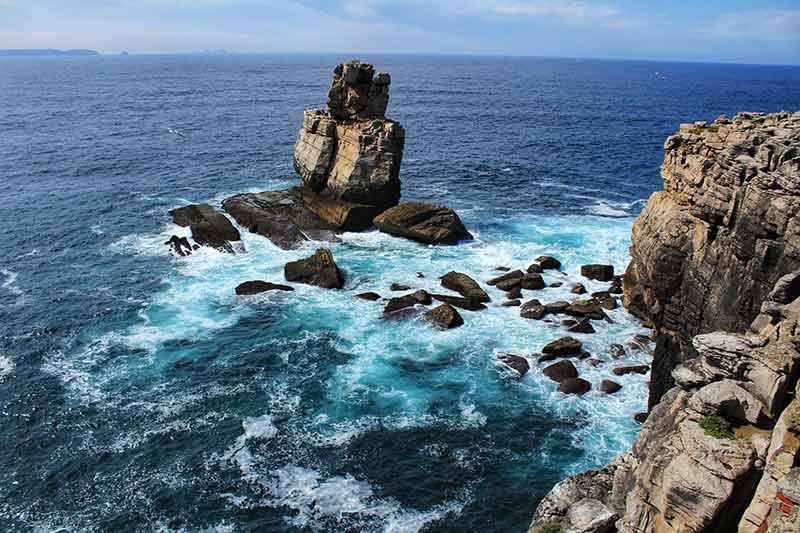 Some of the best beaches in Portugal are in Peniche, well, they’re certainly some of the wildest.
Some of the best beaches in Portugal are in Peniche, well, they’re certainly some of the wildest.This archipelago is a series of small islands between 10 and 17 kilometres (6.2 to 10 miles) offshore from Peniche, 101 km (62 miles) north of Lisbon).
The largest island is Berlenga Grande, just 1.5 km (0.9 miles) by 0.8 km (0.5 miles).
As the islands are a reserve, mostly scientists spend time here, although a few tourists visit to explore the caves and relax in the beautiful natural setting.
A causeway links the mainland to a smaller island where you will find a tourist rest house and the Fort of St. John the Baptist.
The flora is hardy because of the strong winds that blow, while sea birds, marine life and some lizard species make this home.
It’s a beach for the adventurous.
Best Beaches In Portugal – Greater Lisbon
4- Praia do Guincho, Cascais
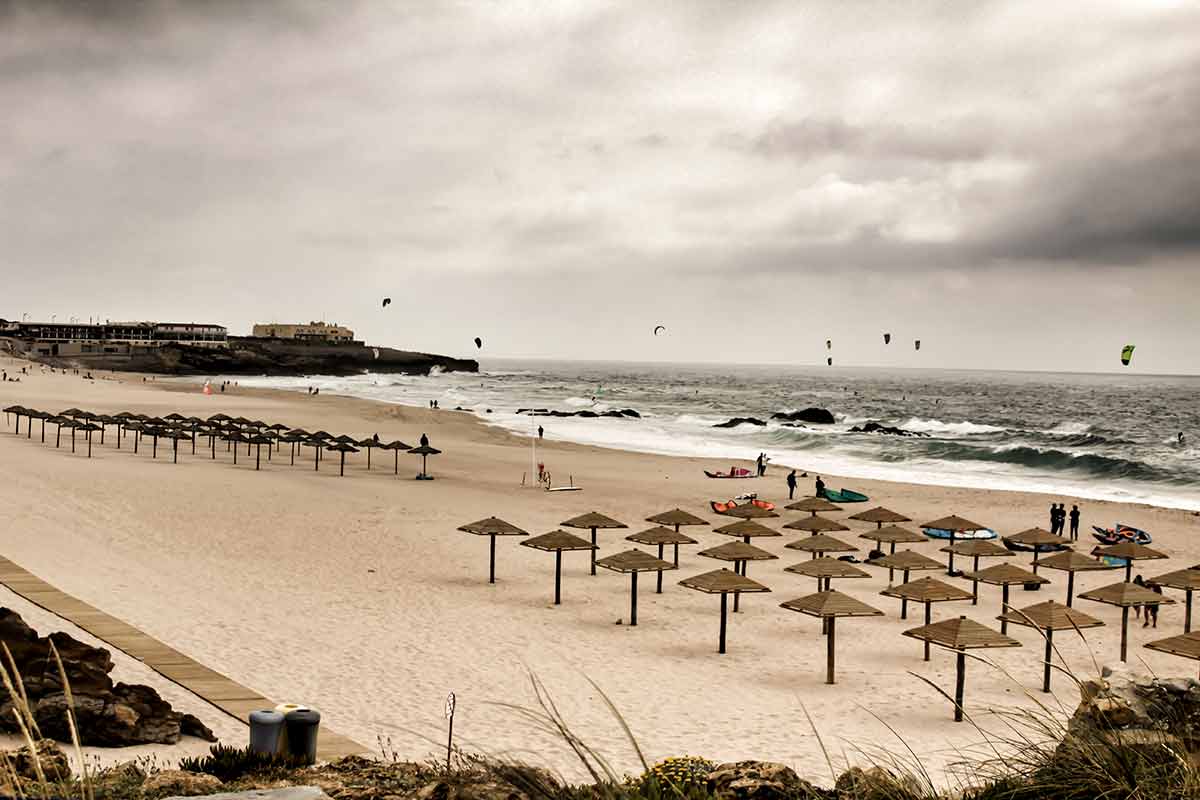 Guincho beach is one of the Portugal beaches near Lisbon.
Guincho beach is one of the Portugal beaches near Lisbon.This small beach is only 800 metres (2620 feet) and is subject to fairly strong northerlies in the summer, making it is a favourite place for surfing, windsurfing and kitesurfing.
The infrastructure supports these activities, and Cascais is a popular tourist destination, so there are plenty of visitors looking for sands to enjoy.
Despite its size, it is never overcrowded, and refreshments are available nearby.
You will enjoy the environment even if it is not the best place for swimming.
The views are lovely, so you will leave feeling rewarded even if you only visit on a walk.
5- Praia da Aguda, Sintra
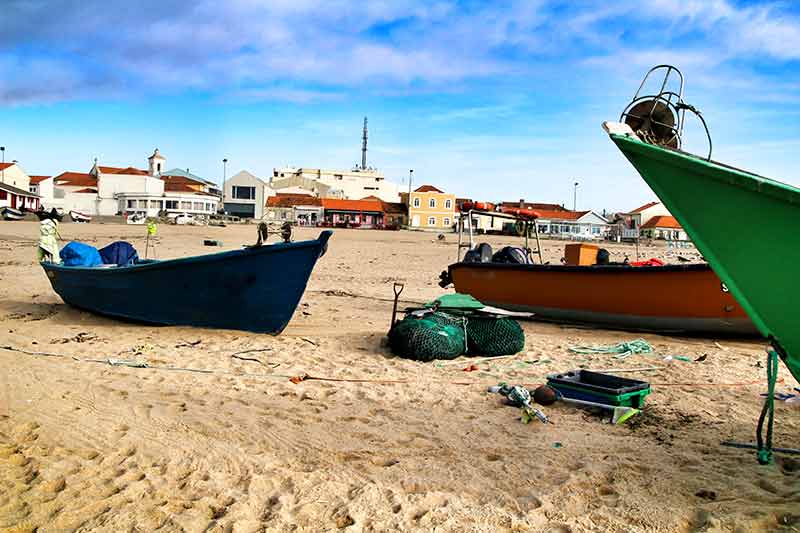 Fishing boats on Aguda Beach in Portugal.
Fishing boats on Aguda Beach in Portugal.You need to get down 230 steps to reach this wild beach, 30 km (19 miles) west of Lisbon, but the reward is there are no crowds.
You are more likely to meet fishermen and naturists than anything else.
Cliffs line the beach, and tidal rock pools are a feature as well.
There may be warnings about going to the beach because of the instability of the rocky cliffs, but people largely ignore them.
If you want to reach the beach by other means, walk along the rocky coastline.
Keep in mind the beach is very narrow at high tide, and there are no lifeguards or facilities.
Also read:
6- Costa da Caprica
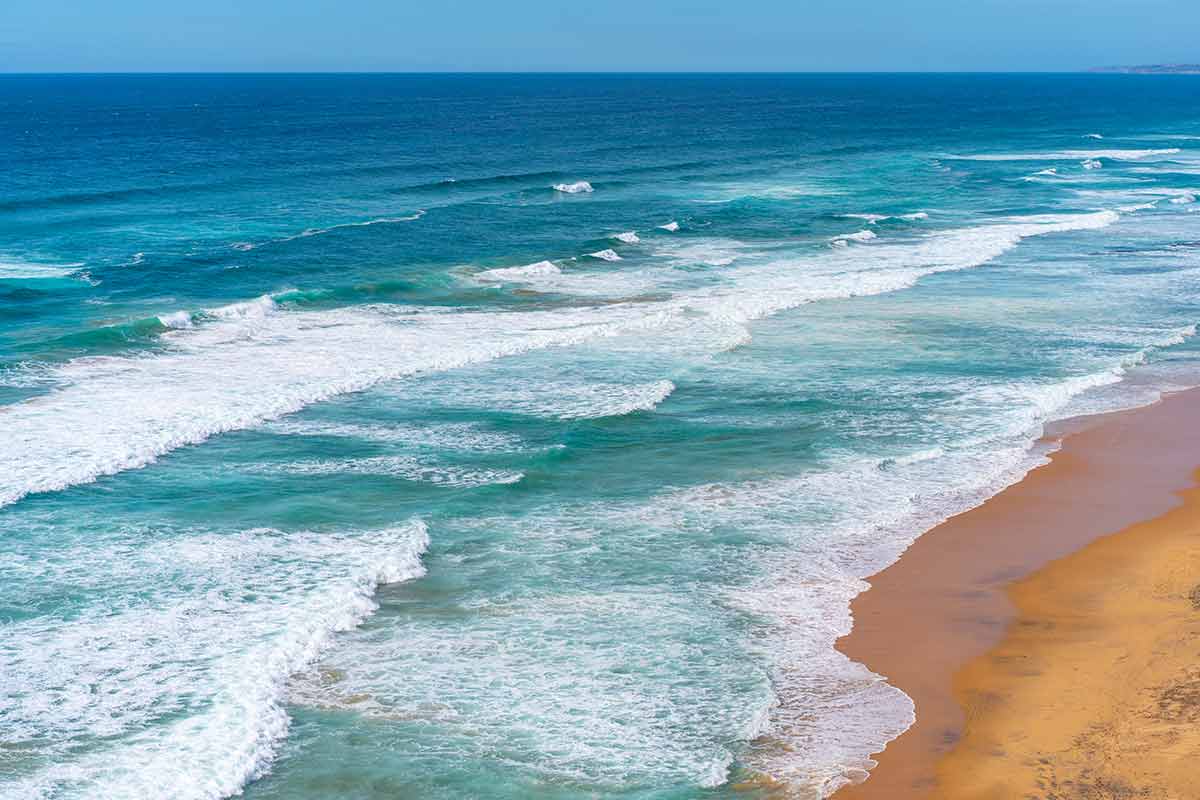 Take your pick of Portugal beaches to explore and enjoy.
Take your pick of Portugal beaches to explore and enjoy.This is the favourite beach location for Lisbon inhabitants, with 15 km (almost 10 miles) of sand backed by dunes.
The central area is trendier while the south attracts naturists.
In the north, jetties help prevent erosion, while blue signs identify the different names of each section of the beach. Although in reality, it is one long stretch of sand.
The north is busier because it is closer to the town, attracting families and surfers. Facilities are better in the north.
The promenade runs parallel in the north, and a tourist train takes passengers further south.
7- Praia do Portinho da Arrabida, Setubal
This beach in Portugal within a national park is as beautiful as they come.
Portinho is a small town within the Arrabida National Park.
Fine white sand and shades of blue water are the rewards at this beach, where it is rarely busy, yet it is a great place to dive to see marine life.
This protected area forbids spearfishing.
You can rent hats and awnings while some small boats are also available.
A pub and restaurant provide refreshments for visitors who can expect security and on-site surveillance.
If you want to go offshore, local charters will take you.
8- Praia da Baleeira, Serra da Azoia
This wild Portuguese beach is only pebbles at high tide but low tide reveals much more.
The small bay is popular with divers, and while it is difficult to access, it is a downhill walk that takes about 15 minutes. But remember it will be uphill coming back.
The beach’s name translates to “paradise”, and it’s never busy, mainly because of its inaccessibility.
It may not be a family favourite, but couples love it.
There are no real facilities, so you need to go prepared, but make sure you take your litter back with you.
Best Beaches In Portugal – South of Lisbon
9- Praia do Carvalhal, Comporta
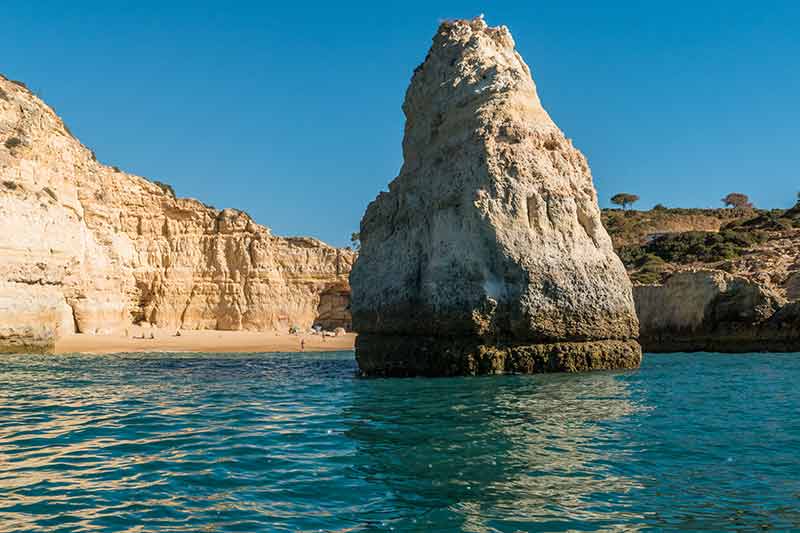 Praia do Carvalho is one of the Portugal beaches that has impressive rock formations to gaze at.
Praia do Carvalho is one of the Portugal beaches that has impressive rock formations to gaze at.Comporta is halfway between Lisbon and the Costa Vicentina to the south. The beach, Praia do Carvalhal, deserves inclusion in this list.
If you are touring and heading south, it’s a good place to stop for a break.
The beach is sheltered by dunes and a pine forest, with the sea calmer than other parts of the Atlantic.
It is just off the main highway and has plenty of parking, showers, toilets, a pub and a restaurant.
You can rent hats and shades at this blue-flagged beach, which also provides surveillance and security.
Portugal Beaches In Costa Vicentina
10- Praia da Franquia, Vila Nova de Milfontes
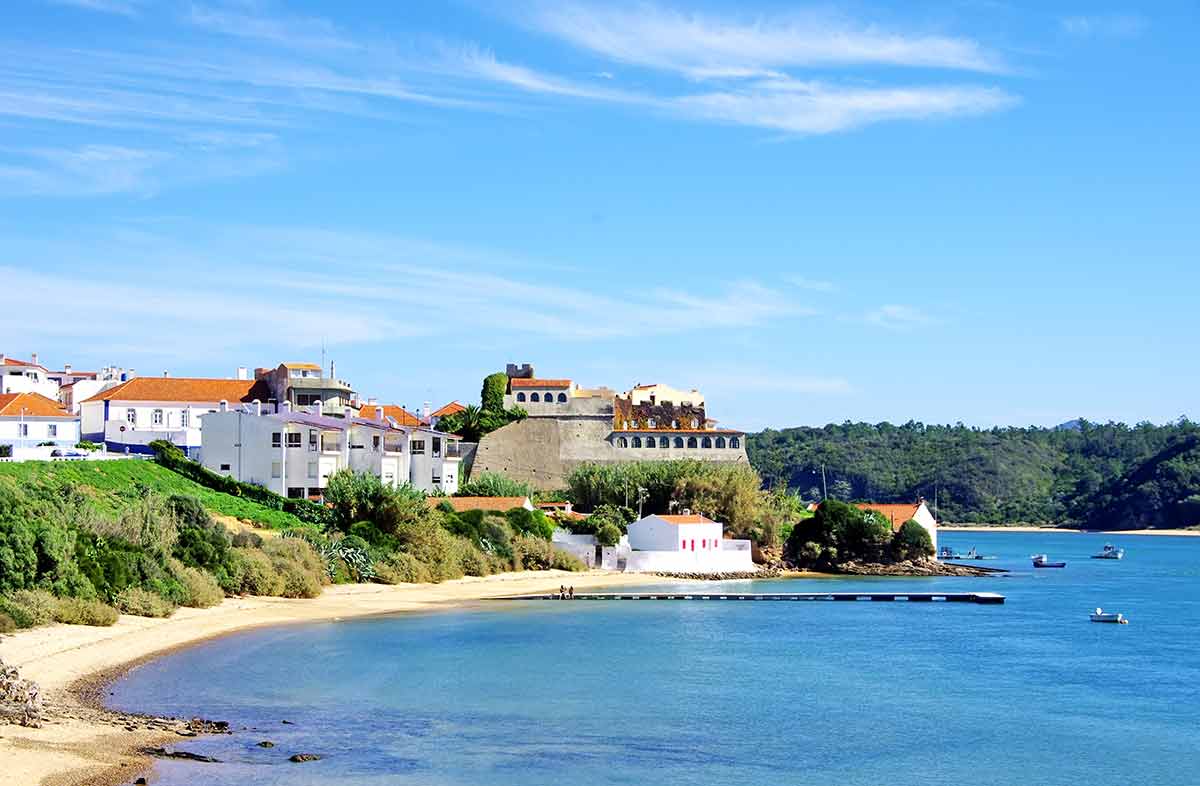 One of the lovely beaches in Portugal can be found in Vila Nova de Milfontes.
One of the lovely beaches in Portugal can be found in Vila Nova de Milfontes.Although Vila Nova de Milfontes is a seaside resort on the Alentejo Coast, Praia da Franquia is a beach on the river as it approaches the sea.
A rocky spur separates it from the coastal beach.
The beauty of this sheltered beach is that its calm waters are ideal for young children.
Canoeing and windsurfing in the breeze are popular water sports.
There are bars and restaurants nearby for refreshments, with fresh seafood prominent on most of the menus.
There is security to stop any problems on this blue-flagged beach, parking close by and hats and awnings available for hire.
11- Praia da Arrifana, Aljezur
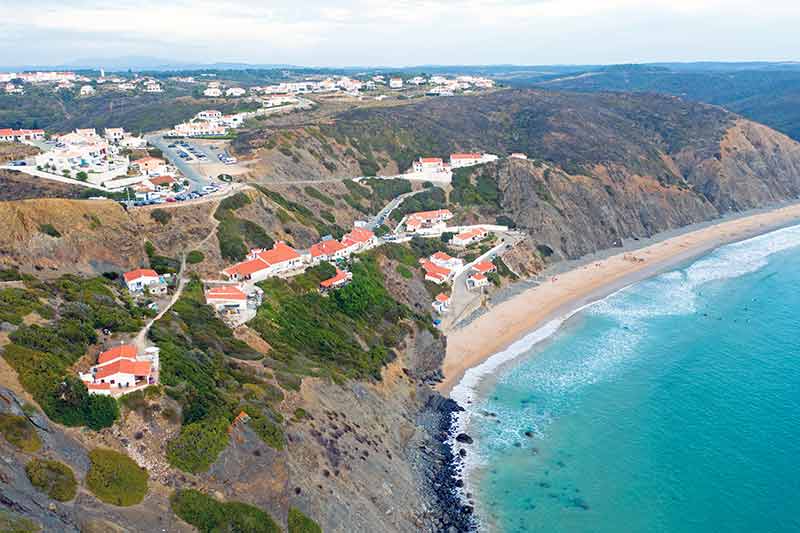 Arrifana Beach is a long strip of sand and a Portuguese beach that you will love.
Arrifana Beach is a long strip of sand and a Portuguese beach that you will love.This beach lies in a small fishing village famous for its barnacles with local cuisine specialities fish stew, octopus in olive oil or sweet potatoes, and fried moray eel.
With blue flag status, this beach has cliffs to provide shelter to encourage sunbathers.
It is popular with scuba divers and surfers with equipment available for hire, including wetsuits.
It is becoming busier, especially at festival time, the annual Sunset Fest and Fisherman’s Festival.
Regular surfing competitions also attract plenty of spectators.
Accommodation is limited, but there is a good campsite just a few minutes north.
12- Praia da Cavaleiro, Odemira
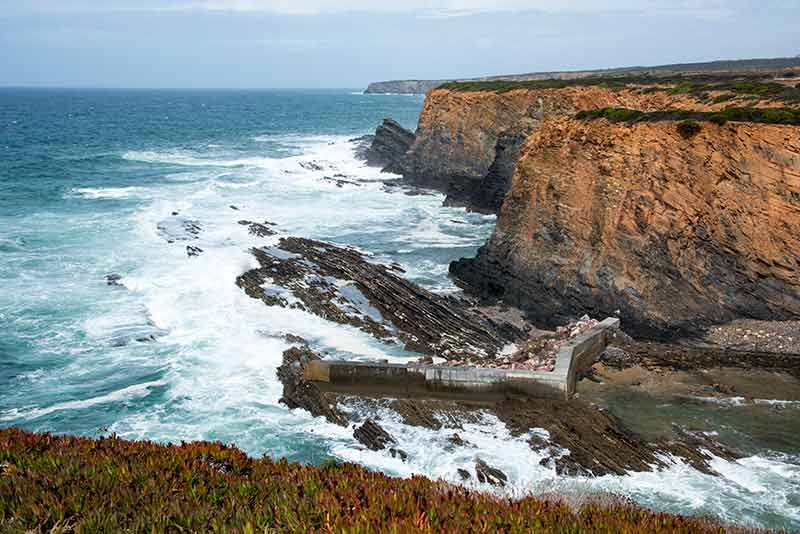 Odemira has some amazing Portuguese beaches.
Odemira has some amazing Portuguese beaches.Knight’s Beach is a small pleasant stretch of sand on the Alentejo Coast with a reputation of being very clean.
You will usually find a breeze, and the lack of supervision here has never been a problem.
You may park nearby and even take your dog, although it is not too accessible.
Its sea shell shape is quite distinctive but take care because the steep steps down can sometimes be a little slippery.
Take in the view before descending.
The lighthouse just a short distance away is also worth a visit while you are there.
13- Praia do Almograve, Alentejo
 Praia do Almograve is one of the amazing surfing beaches in Portugal.
Praia do Almograve is one of the amazing surfing beaches in Portugal.Almograve is larger, with regular surfing and bodyboarding daytime activities.
Cliffs and red dunes surround the beach.
There is security on-site at this blue flag beach with toilet, first aid and restaurant facilities.
This is a rugged stretch of coastline, with Almograve being the best known of several beaches in the region.
You’ll find a lovely sandy crescent at low tide that shrinks markedly at high tide but not right up to the dunes.
It is ideal for families as the beach is just five minutes from the village of the same name.
14- Praia da Amalia, Brejao
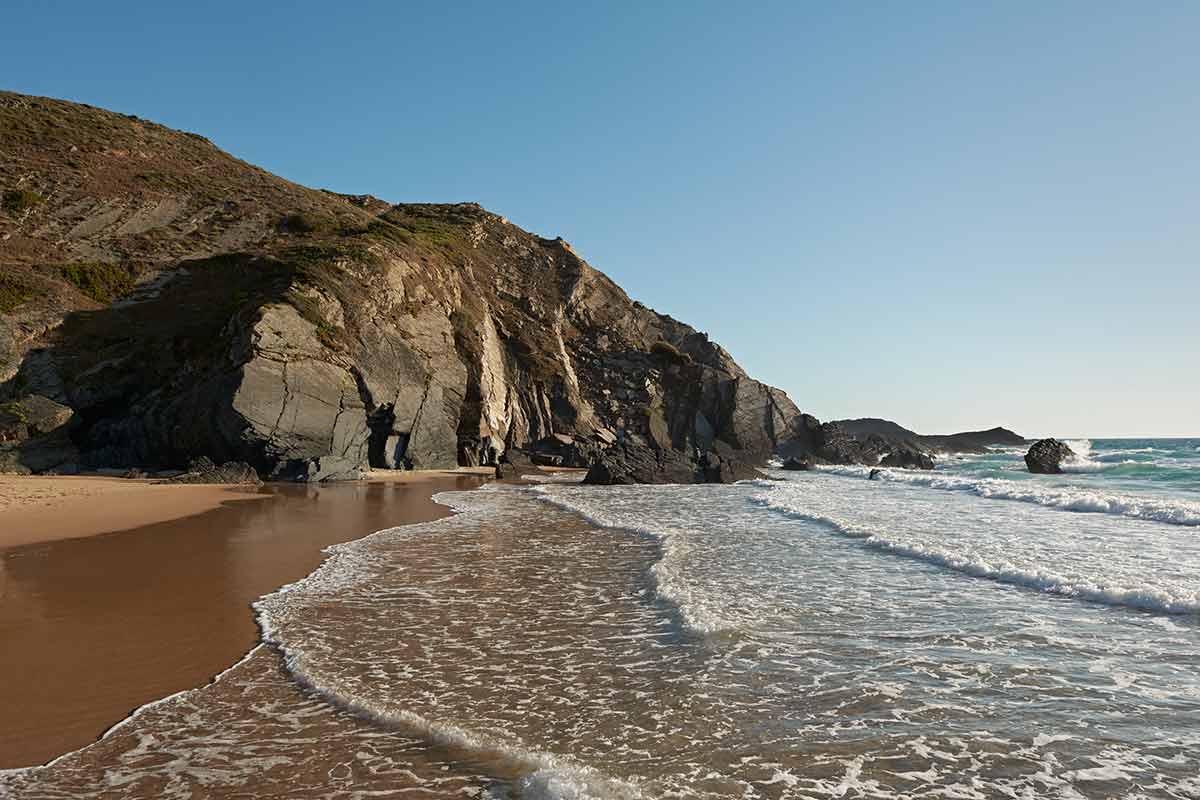 Praia da Amalia is a beautiful beach in Portugal with a beautiful name.
Praia da Amalia is a beautiful beach in Portugal with a beautiful name.This remote beach is not for families simply because of how difficult it is to find it.
You’ll find it in the extreme southwest corner of Portugal, where the coastline begins to head east.
If you are prepared to make an effort, you will find a truly unspoilt stretch of sand by hiking down.
AIt virtually disappears at high tide, but it is a real gem. at low tide.
This Portugal beach takes its name from the country’s most famous fado singer, Amalia Rodriquez, who once stayed in a local villa.
Do not expect facilities, but if you want peace and quiet, Amalia is for you.
Portugal Beaches In The Algarve
15- Praia de Odeceixe
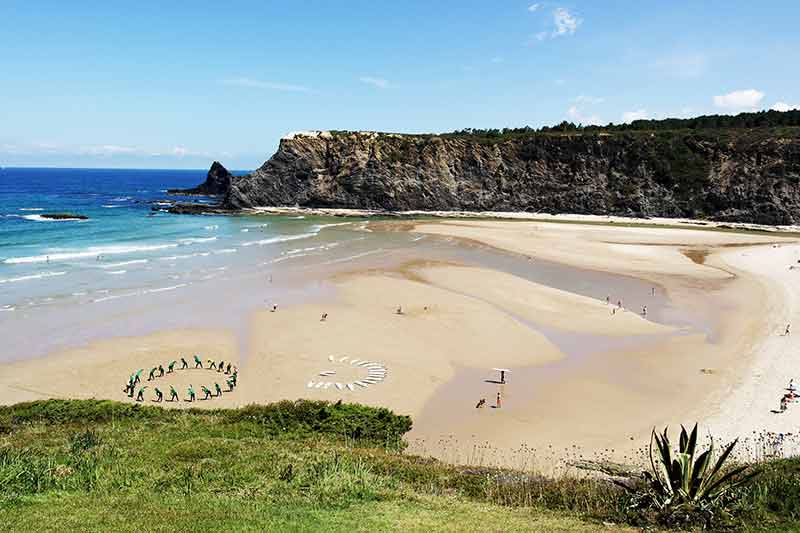 Odeceixe Beach is one of the Portugal beaches to tick off your to-visit list.
Odeceixe Beach is one of the Portugal beaches to tick off your to-visit list.Odeceixe sits at the mouth of Rio de Seixe and is an excellent beach in the extreme southwest.
The approach to the beach is the lush green valley that the river creates.
This is a large beach with sheer cliffs at its northern end and a cove at the south end designated for naturists.
In between, there is plenty of sand, and the waves are popular with surfers.
The village of the same name is three miles away, and a road train links the two in the summer. Although, the pace the train moves at does not get you there quicker than walking.
Shops and cafes offer good facilities to visitors. Odeceixe holds blue flag status.
16- Praia da Cordoama, Sagres
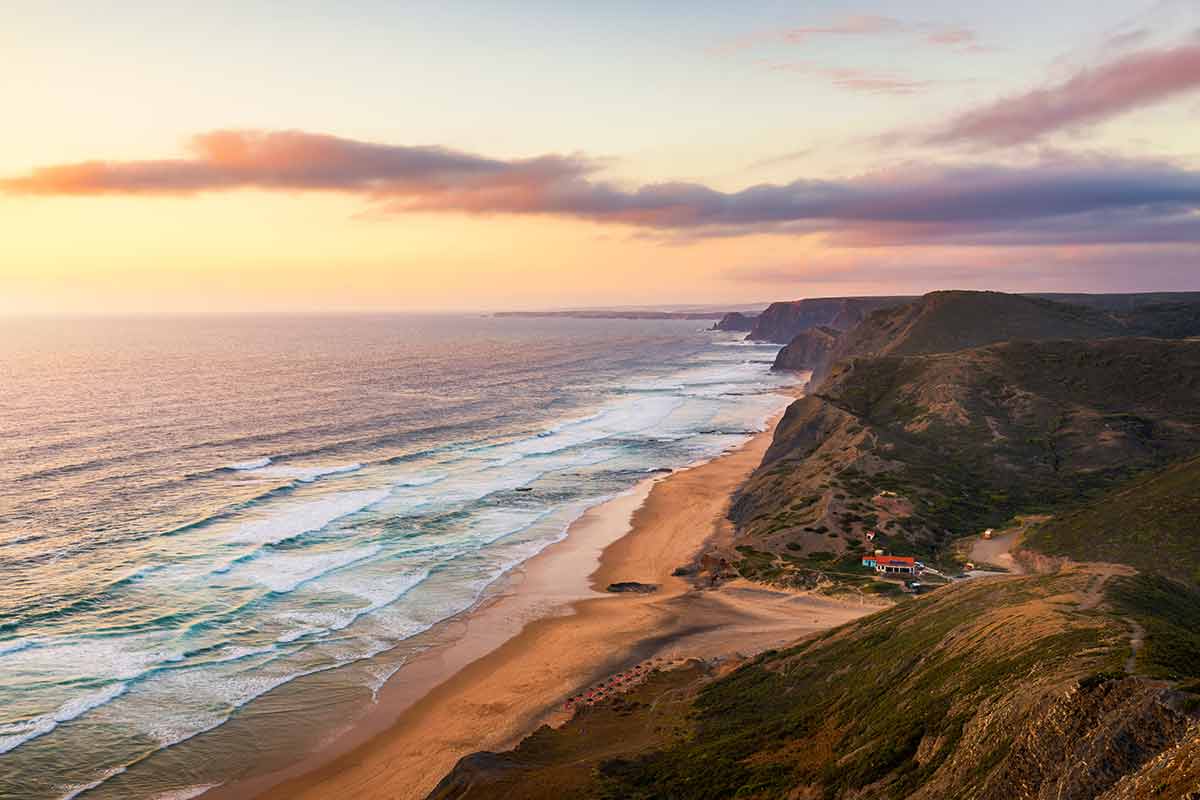 Praia do Cordoama is a wild beach in Portugal you will love for its scenery.
Praia do Cordoama is a wild beach in Portugal you will love for its scenery.This stunning setting involves impressive cliffs and a large stretch of beautiful sand.
The large waves attract surfers, but beach lovers will find the sands attractive once they reach this remote region.
There is often a misty atmosphere early in the morning, but the sun soon burns the mist away.
You will find some pebbles on the beach and rocks in the sea, so it is important to keep your eyes open.
The sea can be quite cool, so this beach is more suitable for adults than children.
17- Praia de Dona Ana, Lagos
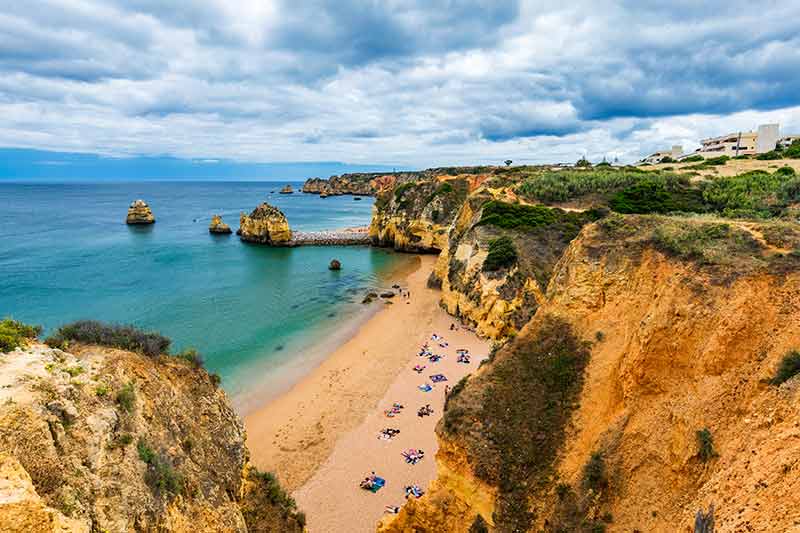 One of the most impressive Portugal beaches is Praia Dona Ana.
One of the most impressive Portugal beaches is Praia Dona Ana.Lagos is a popular tourist destination, and one of the main reasons it attracts visitors is because of its beaches.
Praia de Dona Ana is picturesque and sits south of the resort below cliffs on the Porta da Piedade Headland.
The cliffs offer shelter to beachgoers on a windy day, and erosion of the cliffs reveals golden strata that add to the setting.
Calm waters make this an ideal place for swimming and popular with families.
The infrastructure attracts visitors who will find shops, restaurants, showers and toilets.
The walk from Lagos takes around 20 minutes, but there is a bus service and a road train as alternatives.
18- Praia do Carvalho, Benagil
Carvalho is a sheltered, angular beach overlooked by cliffs with manmade access down to the beach and a bar within the cliffs.
Juniper and dwarf fan palms form a scrub area at the base of the cliffs.
Lichen, golden daisies and liana grow at different times of the year, providing colour and adding to the setting.
The road from Lagos is fine, and parking is available a short walk from the access to the beach.
There are no lifeguards on site or other facilities besides that bar tucked into the cliffs.
19- Praia da Ilha de Faro
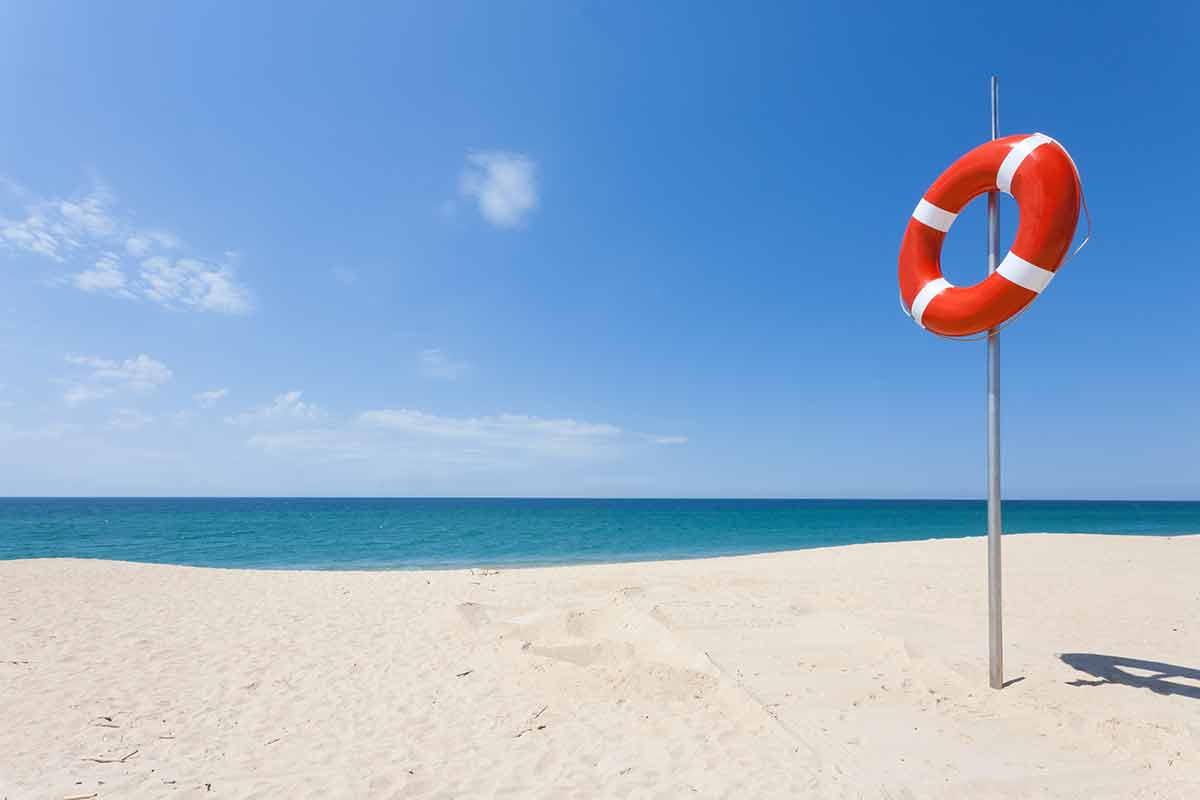 Ilha de Faro is a Portuguese beach with lifeguard facilities.
Ilha de Faro is a Portuguese beach with lifeguard facilities.Faro is the international airport that welcomes tourists to the Algarve. And if you don’t want to travel far after landing, Ilha de Faro is a good beach to enjoy.
The warm water and gentle waves make it a beach in Portugal for everyone to enjoy.
This 5 km (3-mile) stretch of sand along Faro Island links to the mainland over a narrow bridge that crosses the Ria Formosa Natural Park.
The infrastructure is excellent, with suitable activities during the day and bars and restaurants to frequent at night.
Summers are busy, not surprisingly, given that the resort and airport are so close.
20- Praia do Barril, Tavira
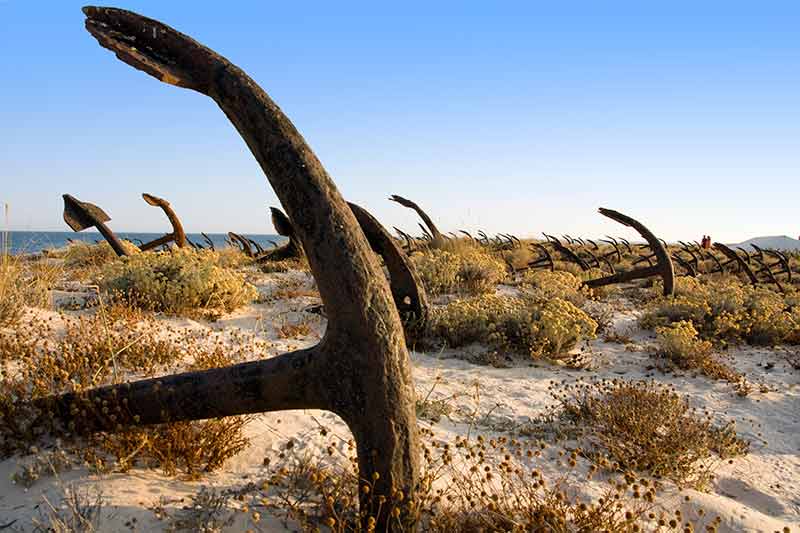 The anchor graveyard at Barril Beach makes it one of the more unique beaches in Portugal.
The anchor graveyard at Barril Beach makes it one of the more unique beaches in Portugal.The anchor cemetery, 100 rusting anchors, is a unique feature of this stretch of sand just a short distance from the town of Tavira.
It is another beach on a small island, one of three found there.
Barril is the most westerly, with soft, white, spotless sand.
The sea is certainly warmer in this Eastern Algarve location than further west.
The beach is a favourite of families yet is large enough never to be too crowded.
There is no shelter such as dunes or cliffs, but there is rarely any significant wind.
Tuna fishing was important here, but the fish have long gone.
Those anchors secured the tuna fishing nets at one time.
The buildings that fell into disrepair have found a new function; bars, restaurants and shops for the emerging tourist trade.
For more beaches around the world read:

